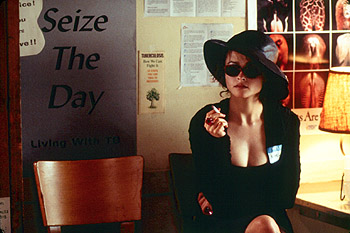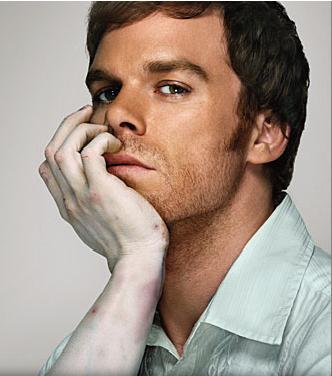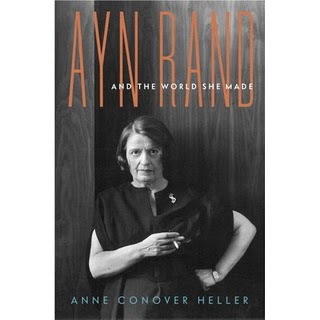Book Review: Ayn Rand and the World she Created by Anne C. Heller
- 8 minutes read - 1557 words
Marla… the little scratch on the roof of your mouth that would heal if only you could stop tonguing it, but you can’t.
From “Fight Club”
There are those people, those special, special people who as much as you find reason(s) to be repelled by them – their boorish talk, their penchant for racist assumptions, the way they treat special moments of your life as a roadbump on the way to saying what they wanted to say, the way they indiscreetly ogle women as you talk to them – somehow you just can’t excise their cancerous character from your life.
You damn them when you go home: “I can’t believe she said that, that snarky bitch” or “Did you see him talk the entire time to her D-cups?” and yet somehow, someway they fascinate us with their disregard for the rules. I’m pretty sure this has something to do with the power psyochpaths have among the general population, as an aside.

Making the curiosity cocktail all the more potent, occasionally, amidst all that slovenliness or booziness or smacking of gum or incessant smoking, is a silver beam of heroism, brilliance, style, or sex appeal that casts a glamour on you. “She donated how much to the children?” or “He saved the old lady by rushing her in his arms to the ER?”
You question your assumptions and hold on to a crumb of hope that they were really more like this good person and less like that hideous being you dislike. If only you could get more of that good quality and less of the other. Perhaps the only solution is to hang around them more so that you can see these great qualities. Yes, that’s right.
…And then that Jeckyll side comes back out and they infuriate and disappoint you anew.
I don’t know what the DSM-IV specification for this type of personality is, or what the specification is for the sucker who is mesmerized thereby, but it describes my relationship with the oeuvre of Ayn Rand. She beguiles and then revolts me with a one-two rhythm befitting unto windshield wipers.

She has a seductive way of writing about the poetry of the industrial age. She describes coke being blasted in industrial funaces, burning crucibles of steel pouring golden, flaming liquified power as (handsome!) men in hard hats look on – square-jawed and draped in the sartorial perfection of the “Mad Men” era. And these titans, these thinkers, these doers, these uber-beings bearing strong names like Howard, Dominique, and Dagny, they do great things and bend before nothing. They pay no mind to sycophants or reputation, they do what’s right by their own measure for their own benefit and don’t let any morality of bad faith slow the locomotive of their own genius. Reading of their lives and their passionate existences can run a reader to the top of a lofty peak where s/he inhales pure air and see the sunrise of a better tomorrow.
But for these visions and vistas, for imagining Angelina Jolie as Dagny in “Mad Men” garb in the mini-series version, you may almost miss the philosophical system underneath that has some uncomfortable ends. State-run hospitals for, as Rand called them, “sub-normals” should be shut down. In her portrayals, female sexual fulfillment necessarily borders on hero-worship and effectively calls for her to seek to be overpowered. And those living through these contracting economic times certainly have reason to pause at Rand’s philosophy’s suggestion that a more deregulated economy is needed.
Like Marla from “Fight Club” cited above, in my teens I couldn’t shake this (sick?) fascination with Rand’s world. This lead to reading Rand’s non-fiction work and reading Barbara Branden’s memoir “The Passion of Ayn Rand.” Like an overoptimistic girlfriend, I thought that perhaps by understanding Rand’s history better I could find a way to get rid of those nasty bits and have her poetry without the nausea.
If anything, the biography made it harder to tolerate Rand’s reasoning lived as her own life. She would not give up smoking until she had lung cancer owing to “lack of sufficient evidence.” She forced her husband and her protege’s wife to accept a open affair (I believe that’s called “open marriage” these-a-days) between her and the protege, Nathaniel Branden. In later years, Her YouTube videos show a harsh, severe person who’s tolerance for dissent is non-existent and whose favorite tools for debate were refusal to engage, weeding out dissenting parties, and Soviet-style “disownments.” Amidst these character assassinations and purges she radiates a Nixonian aura of paranoia.
When I heard that a new Rand biography was in release I again felt that urge to visit Rand-land and see if an intrepid researcher had somehow found something that could make it all hang together for me. Heller’s biography is well-researched, revealing, and entirely compelling. Heller starts with Rand’s youth in Russia, where she sees the collapse of the Tsar, the rise of Kerensky, and the Bolshevik authoritarian crackdown and takeover. Heller also gives full consideration to Rand, nee Rosenbaum’s Jewish identity. Her father’s business was seized by the Bolsheviks and she had to endure the debilitating “tolerance” edicts that ghettoized and marginalized Jews and generally used them as a source of money when the Tsar’s coffers ran light. Heller’s research into Rand’s mother (“a little bit pink”), a social climber and Communist collaborator explains the callow, infantilizing mother character so often present in Rand’s work. Rand’s female role model exploration is paired with an examination of the roots of her masculine paragon. Rand’s sexual / heroic / intellectual male protagonists (in Rand’s thought the intellectual man is the sexual ideal and is never separate from his own sense of heroism) derive from her favorite teenage books: French picaresques where dashing Western Europeans subjugate voodoo powers in darkest Africa, darkest India, or in the wastes of the lands of The Great Game. These facets of a tumultuous childhood full of idealistic reasoning and hero-identification help explain some of the wooden, absolutist characterization seen in her novels.
Heller’s research also presents how Rand was the benificiary of altruistic kindness of others. This is decidedly against the Rand ur-myth. Rand’s relatives in America shelter her, help her out, and provide her some of the opportunities that give her the chance encounters that net her a career in screenwriting. While it’s important to note that Rand never had anything handed to her and her own spark and initiative certainly were the core personality traits that allowed her to advance, she did not do it in a vacuum, an orphan struggling entirely unaided.
Heller’s presentation of the intellectual content of We the Living, The Fountainhead, and Atlas Shrugged all provide a fair synopsis of the philosophical underpinnings of the books and Heller deftly identifies and traces the thread of “a Romantic ‘sense of life’” that Rand considered the basis for living well and thinking clearly. Heller cogently presents this system and manages to do so without sounding awed or pronouncedly skeptical. She describes these ethical systems with the neutrality of someone explaining a catalytic converter and her restraint and balance is to be lauded.
After the zenith of Atlas Shrugged’s publication, the rest of the tale is anticlimax. The superstar, the public intellectual begins to be surrounded by sycophants and intellectual hollow men. Before long they make a world around her where everyone walks on eggshells, everyone agrees with She Who Must be Obeyed, and dissenters are cut loose of their social support system as a punishment for invoking her ire. While I’ll stop short of calling it a “cult,” the occasional insistence of breaking family ties, leaving spouses, or being forced to tolerate the sexual infidelities (“Hey there, Bob, Larry there is Suzy’s romantic ideal, so, uh, can you arrange to be home late on Thursday night? Don’t worry, it’s not infidelity, it’s her being true to her Romantic sense of life. Mm’kay?”) definitely shows a dangerous insularity.
It was only when I considered this third act that I understood Heller meant “the world [Rand] made” not as the world of the aspiring, selfish individualist portrayed in her writing, but the world of hollow toadies and purges. The world she made, indeed.
But where did this leave me in my quest to attempt to sort out this maddening woman’s writing? Heller helped me find roots in her thinking, continuity in her actions, and helped me see the person more as the person in herself minus the reverential apologia of the remnants of her circle. Rand was brave and right in many ways. She correctly limned Communism’s philosophical implications, she decried racism (as uncaptalistic!), she dared be an open atheist, she portrayed strong female protagonists more interested in careers than suburbs with children and iceboxes in the 40’s, she was pro-choice, and she dared bring discussions of “rougher” sexual desire to the popular mind in some ways heralding the identity politics coming in the 70’s and 80’s. But she was also a real, vital, person. A person who cherished rationality so dearly that the hint that she was irrational was a slap to the face. She was a person who clung so tightly to the syllogism that she couldn’t see her blind spots. She overused amphetamines. In short, she was a person of her times, a times a contradictory mess.